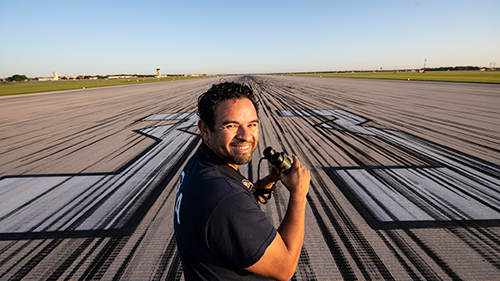About Wildlife Services

APHIS' Wildlife Services leads our Nation’s efforts to manage conflicts between people and wildlife so they can coexist.
Wildlife are one of America’s most valued public resources. Yet in the dynamic landscape we share, wildlife-related problems—livestock predation, crop losses, property damage, disease threats, and more—are common. We work nationwide to help solve these problems while considering a wide range of public interests.
The four main goals of Wildlife Services are to:
- Provide wildlife services, protecting agriculture, wildlife and other natural resources, property, and human health and safety.
- Develop effective methods and strategies with technology that is biologically, environmentally, and socially sound.
- Value and invest in people with an organizational culture that promotes innovation as Federal leaders of wildlife management.
- Inform and communicate. Collect and analyze internal and external communication to build an understanding of the Federal role in these efforts.
Wildlife Services At-a-Glance
Here's a snapshot of our accomplishments in 2022 (15.96 MB), maintaining balanced, healthy wildlife populations.
- Maintained or created 32,781 different agreements with cooperators to protect livestock from predation through a combination of techniques and tools, including nonlethal methods like range riding, fladry, fencing, and husbandry practices
- Led U.S. research to find innovative solutions for managing wildlife damage, initiating 197 studies with approximately 171 research partners nationwide—with the majority of our work devoted to nonlethal tools and techniques
- Continued researching and promoting nonlethal methods to cooperators nationwide under the Nonlethal Initiative, which started in 2020 to protect livestock from large carnivores
- In a One Health initiative with Federal, State, and Tribal partners, monitored and surveyed thousands of white-tailed deer and other animals (both wild and domestic) for SARS-CoV-2 to help identify species that may serve as reservoirs or hosts for the virus and better understand exposure, disease susceptibility, and the risks of cross-species transmission
- Protected wildlife and public health by distributing more than 8.5 million oral rabies vaccination (ORV) baits to combat raccoon rabies in 16 Eastern States and more than 1.2 million ORV baits in Texas to prevent canine rabies from reemerging along the Mexican border
- Partnered with Federal and State resource agencies, private organizations, and community groups on approximately 7,250 damage management projects that helped protect threatened and endangered bird species across 50 States, Guam, and the U.S. Virgin Islands
- Worked with State and Federal partners to reduce or prevent feral swine damage on approximately 231 million acres in 36 States and 3 Territories, directly protecting agriculture, human health and safety, property, and natural resources
- Helped nearly 784 civil, military, and joint-use airports worldwide—comprising about 75 percent of all U.S. commercial passenger airports—reduce or avoid wildlife strike hazards to protect people and aircraft
These accomplishments are only scratching the surface. In our 5-year strategic plan, we have worked to optimize our efforts and build public trust as we partner with State and local governments and agencies. Here are some of our top strategic priorities:
- Revitalize and increase the profile of the integrated wildlife damage management approach
- Improve and increase Wildlife Services' capabilities related to wildlife disease and emergency response
- Improve harmonization of Wildlife Services' research and operational functions
- Leverage high-impact technology
See our Strategic Summary (461.93 KB) and Wildlife Services Strategic Plan: Fiscal Years 2020-2024 (5.16 MB) for more information on our immediate goals.
Wildlife Services in Action
Take a look at our boots-on-the-ground Wildlife Services employees across the United States.
Each employee strives to reduce damage caused by wildlife to the lowest possible levels while at the same time reducing wildlife mortality and protecting Tribal lands and culture. They manage a delicate balance between the needs of people and the needs of wildlife. Wildlife Services employees protect people from wildlife strike hazards at airports and protect sea turtles along the Atlantic, Pacific, and Gulf coasts. They deliver rabies vaccines to protect communities from the ecological and economic impacts of this deadly disease. In doing so, they keep our Nation safe every day.
Stay in the Know
For the latest news about Wildlife Services, sign up for email updates.











